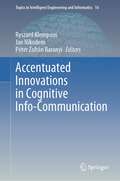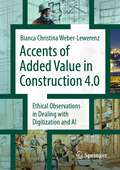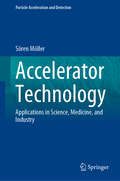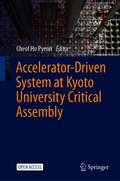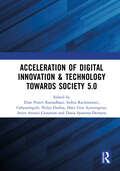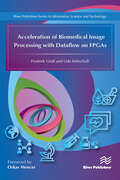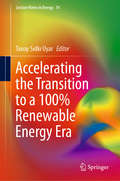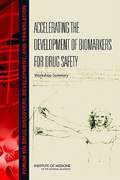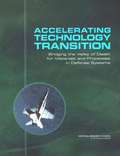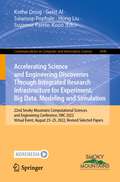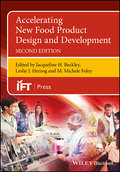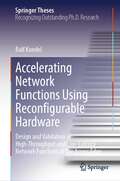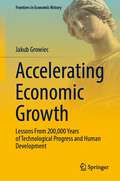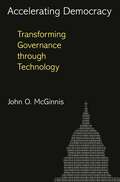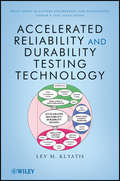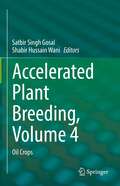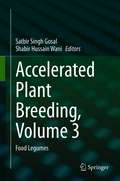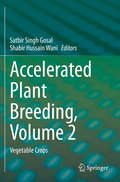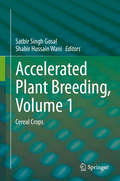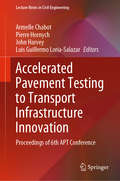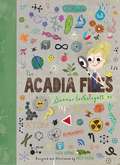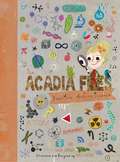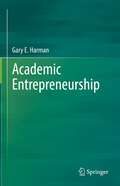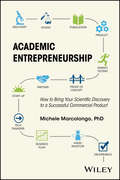- Table View
- List View
Accentuated Innovations in Cognitive Info-Communication (Topics in Intelligent Engineering and Informatics #16)
by Ryszard Klempous Jan Nikodem Péter Zoltán BaranyiConsidering the emergence of artificial intelligence, virtual and augmented reality, 3D video and television, and holography, it is logical that we should also begin to create applications and businesses driven by these technologies. The 12 chapters of Accentuated Innovations in Cognitive Info-Communication focus on the research and development of state-of-the-art information in Cognitive Info-Communication. This interdisciplinary research area has emerged as a synergy between Info-Communication and Cognitive Sciences. It presents a synthetic, holistic combination of coherent technologies that will become increasingly important in the coming decade. It is a teaching and reference guide for VR, robotics, virtual classrooms and institutions, and medicine at the undergraduate and postgraduate levels. The discussed book is an immersive learning experience for students and teachers worldwide. In addition, it applies to other fields such as healthcare, performing arts, and television.
Accents of added value in construction 4.0: Ethical observations in dealing with digitization and AI
by Bianca Christina Weber-LewerenzThe book wants to do justice to the complexity surrounding the Digital Transformation and AI in the Construction Industry. User practice experiences show how digital change can be shaped sensibly and constructively, what kind of methods and technologies do exist or can be developed, which fields of application can be explored, by keeping an eye on risks and opportunities.The book works out key factors and core competencies at all levels, which are decisive both for sustainably using innovative technologies and for setting the Seal of Quality of the Construction Industry at home and abroad.
Accelerator Technology: Applications in Science, Medicine, and Industry (Particle Acceleration and Detection)
by Sören MöllerThis book explores the physics, technology and applications of particle accelerators. It illustrates the interconnections between applications and basic physical principles, enabling readers to better understand current and upcoming technologies and see beyond the paradigmatic borders of the individual fields. The reader will discover why accelerators are no longer just toys for scientists, but have also become modern and efficient nuclear workhorses. The book starts with an introduction to the relevant technologies and radiation safety aspects of accelerating electrons and ions from several keV to roughly 250 MeV. It subsequently describes the physics behind the interactions of these particle beams with matter. Mathematical descriptions and state-of-the-art computer models of energy-loss and nuclear interactions between the particle beams and targets round out the physics coverage. On this basis, the book then presents the most important accelerator applications in science, medicine, and industry, explaining and comparing more than 20 major application fields, encompassing semiconductors, cancer treatment, and space exploration. Despite the disparate fields involved, this book demonstrates how the same essential technology and physics connects all of these applications.
Accelerator-Driven System at Kyoto University Critical Assembly
by Cheol Ho PyeonThis open access book is a unique compilation of experimental benchmark analyses of the accelerator-driven system (ADS) at the Kyoto University Critical Assembly (KUCA) on the most recent advances in the development of computational methods. It is devoted especially to nuclear engineers and scientists. Readers will find a detailed description of advanced measurement techniques and calculation methodologies for the ADS with 14 MeV neutrons and high-energy neutrons (with combined use of 100 MeV protons and Pb-Bi target) at KUCA. Additionally, experimental results of nuclear transmutation of minor actinides by ADS and at a critical state are included. Readers also have access to benchmarks of specific ADS experiments with raw data in the Appendix. The book is a valuable resource for the ADS experiments at KUCA which are globally recognized as both static and kinetic studies from the point of view of fundamental research.
Acceleration of Digital Innovation & Technology towards Society 5.0: Proceedings of the International Conference on Sustainable Collaboration in Business, Information and Innovation (SCBTII 2021), Bandung, Indonesia, 28 July 2021
by Dian Puteri Ramadhani Indira Rachmawati Cahyaningsih Nidya Dudija Hani Gita Ayuningtias Arien Arianti Gunawan Dania Syanetta DennyraSustainable Collaboration in Business, Technology, Information, and Innovation (SCBTII 2021) focused on "Acceleration of Digital Innovation & Technology towards Society 5.0". This proceeding offers valuable knowledge on research-based solutions to accelerate innovation and technology by introducing economic transformation to solve various challenges in the economy slow-down during the post-pandemic era. The business sector should have the ability to gain sustainable competitive advantage, and quality growth by synergizing management capabilities, mastery of technology, and innovation strategies to adapt to external trends and events. This Proceeding is classified into four tracks: Digital-Based Management; Strategy, Entrepreneurship, Economics; Finance and Corporate Governance; and Accounting. This valuable research will help academicians, professionals, entrepreneurs, researchers, learners, and other related groups from around the world who have a special interest in theories and practices in the field of business and digital innovation and technology towards society 5.0.
Acceleration of Biomedical Image Processing with Dataflow on FPGAs
by Frederik Grüll Udo KebschullShort compute times are crucial for timely diagnostics in biomedical applications, but lead to a high demand in computing for new and improved imaging techniques. In this book reconfigurable computing with FPGAs is discussed as an alternative to multi-core processing and graphics card accelerators. Instead of adjusting the application to the hardware, FPGAs allow the hardware to also be adjusted to the problem. Acceleration of Biomedical Image Processing with Dataflow on FPGAs covers the transformation of image processing algorithms towards a system of deep pipelines that can be executed with very high parallelism. The transformation process is discussed from initial design decisions to working implementations. Two example applications from stochastic localization microscopy and electron tomography illustrate the approach further. Topics discussed in the book include:• Reconfigurable hardware• Dataflow computing• Image processing• Application acceleration
Accelerating the Transition to a 100% Renewable Energy Era (Lecture Notes in Energy #74)
by Tanay Sıdkı UyarThis book discusses renewable energy systems and applications, and demonstrates how an accelerated transition to 100% renewable energy can be achieved. It examines the systems from a thermodynamic perspective, focusing on the irreversible aspects of the current energy system and highlighting the solutions developed to date. Presenting global research and developments, this book is intended for those working within the field of renewable energy research and policy who are interested in learning how they can contribute to the transition from fossil fuels to renewable resources.
Accelerating the Development of New Drugs and Diagnostics: Workshop Summary
by Steve OlsonAdvances in technologies and knowledge are creating new avenues for research and opportunities for the discovery and clinical development of innovative therapies and diagnostics. However, despite these opportunities, only a small fraction of investigational products are successfully developed into cures and therapies that can be accessed by patients. One response to the ever-widening gap between the number and promise of basic scientific discoveries and the translation of those discoveries into therapies is a renewed emphasis on collaborative approaches among federal agencies, academia, and industry, all directed at the advancement of the drug development enterprise. The newly developed Cures Acceleration Network (CAN)-a part of the National Center for Advancing Translational Sciences (NCATS) within the National Institutes of Health (NIH)-has the potential to catalyze widespread changes in NCATS, NIH, and the drug development ecosystem in general. On June 4-5, 2012, the IOM Forum on Drug Discovery, Development, and Translation held, at the request of NCATS, a workshop-bringing together members of federal government agencies, the private sector, academia, and advocacy groups-to explore options and opportunities in the implementation of CAN. Accelerating the Development of New Drugs and Diagnostics: Maximizing the Impact of the Cures Acceleration Network: Workshop Summary summarizes the workshop.
Accelerating the Development of Biomarkers for Drug Safety: Workshop Summary
by Institute of Medicine of the National AcademiesBiomarkers can be defined as indicators of any biologic state, and they are central to the future of medicine. As the cost of developing drugs has risen in recent years, reducing the number of new drugs approved for use, biomarker development may be a way to cut costs, enhance safety, and provide a more focused and rational pathway to drug development. On October 24, 2008, the IOM's Forum on Drug Discovery, Development, and Translation held "Assessing and Accelerating Development of Biomarkers for Drug Safety," a one-day workshop, summarized in this volume, on the value of biomarkers in helping to determine drug safety during development.
Accelerating Technology Transition: Bridging the Valley of Death for Materials and Processes in Defense Systems
by Committee on Accelerating Technology TransitionAccelerating the transition of new technologies into systems and products will be crucial to the Department of Defenses development of a lighter, more flexible fighting force. Current long transition times-ten years or more is now typical-are attributed to the complexity of the process. To help meet these challenges, the Department of Defense asked the National Research Council to examine lessons learned from rapid technology applications by integrated design and manufacturing groups. This report presents the results of that study, which was based on a workshop held to explore these successful cases. Three key areas emerged: creating a culture for innovation and rapid technology transition; methodologies and approaches; and enabling tools and databases.
Accelerating Science and Engineering Discoveries Through Integrated Research Infrastructure for Experiment, Big Data, Modeling and Simulation: 22nd Smoky Mountains Computational Sciences and Engineering Conference, SMC 2022, Virtual Event, August 23–25, 2022, Revised Selected Papers (Communications in Computer and Information Science #1690)
by Kothe Doug Geist Al Swaroop Pophale Hong Liu Suzanne Parete-KoonThis book constitutes the refereed proceedings of the 22nd Smoky Mountains Computational Sciences and Engineering Conference on Accelerating Science and Engineering Discoveries Through Integrated Research Infrastructure for Experiment, Big Data, Modeling and Simulation, SMC 2022, held virtually, during August 23–25, 2022. The 24 full papers included in this book were carefully reviewed and selected from 74 submissions. They were organized in topical sections as follows: foundational methods enabling science in an integrated ecosystem; science and engineering applications requiring and motivating an integrated ecosystem; systems and software advances enabling an integrated science and engineering ecosystem; deploying advanced technologies for an integrated science and engineering ecosystem; and scientific data challenges.
Accelerating New Food Product Design and Development
by M. Michele Foley Leslie J. Herzog Jacqueline H. BeckleyWritten primarily for directors and managers of food design and development, food scientists, technologists, and product developers, this book explains all the necessary information in order to help meet the increasing demands for innovation in an industry that is providing fewer resources. This updated edition, by a group of seasoned food industry business professionals and academics, provides a real-world perspective of what is occurring in the food industry right now, offers strategic frameworks for problem solving and R&D strategies, and presents methods needed to accelerate and optimize new product development. Accelerating New Food Product Design and Development, Second Edition features five brand new chapters covering all the changes that have occurred within the last decade: A Flavor Supplier Perspective, An Ingredient Supplier Perspective, Applying Processes that Accelerate New Product Development, Looking at How the University Prepares Someone for a Career in Food, and Innovative Packaging and Its Impact on Accelerated Product Development. Offers new perspectives on what really goes on during the development process Includes updated chapters fully describing the changes that have occurred in the food industry, both from a developer’s point of view as well as the consumer requirements Features a completely rewritten chapter covering the importance of packaging which is enhanced through 3D printing All of this against the impact on speed to market Filled with unique viewpoints of the business from those who really know and a plethora of new information, Accelerating New Food Product Design and Development, Second Edition will be of great interest to all professionals engaged in new food product design and development.
Accelerating Network Functions Using Reconfigurable Hardware: Design and Validation of High Throughput and Low Latency Network Functions at the Access Edge (Springer Theses)
by Ralf KundelThis book reports on new concepts and methods to design network functions on programmable hardware to accelerate connectivity. First, it introduces the host bypassing concept for improved integration of hardware accelerators in computer systems operating 5G radio access networks. This novel concept bypassed the system’s main memory and established direct connectivity between the accelerator and network interface card. This concept leads to improved throughput and significantly lowered latency jitter compared to existing methods. Second, the book analyzes different programmable hardware technologies for hardware-accelerated Internet subscriber handling, including three P4-programmable platforms and FPGAs. It shows that all the approaches have excellent performance and are suitable for Internet access creation. In turn, it presents a fully-fledged accelerated User Plane Function (UPF) designed upon these concepts and its testing in an end-to-end 5G standalone network. Third, it analyses and demonstrates the usability of Active Queue Management (AQM) algorithms on programmable hardware as an expansion to the access edge. It shows the feasibility of the CoDel AQM algorithm and discusses the challenges and constraints to be considered when limited hardware is used, resulting in significant improvements in the Quality of Service. Furthermore, the P4STA measurement framework is introduced, a network function benchmarking concept combing precise hardware-based time measurement methods with software-based load generation to simultaneously ensure high measurement accuracy and flexibility. Researchers and professionals will find in this book new solutions to improve both fixed and mobile internet access networks, offering an informative and inspiring reading for researchers and professionals involved in building the next generation of access edge networks and underlying technology.
Accelerating Economic Growth: Lessons From 200,000 Years of Technological Progress and Human Development (Frontiers in Economic History)
by Jakub GrowiecWhat made it possible for the human species to conquer the world, build a global digital economy, and still want more? What drives technological progress and economic growth in the long run and on a global scale? And how will technological progress, economic growth, and the overall prosperity of human civilization unfold in the future? This book sheds new light on these big questions by incorporating findings from physics, anthropology, psychology, history, philosophy, and computer science in a brand-new theory of economic growth. Looking back across the millennia, it identifies five major technological revolutions which have transformed humankind’s capacity to process energy and information—the cognitive, agricultural, scientific, industrial, and digital revolutions—and characterizes the new avenues of economic development which they have opened while also exponentially accelerating growth.
Accelerating Democracy: Transforming Governance Through Technology
by John O. McGinnisHow to adapt democracy to the accelerating pace of technological change—and why it's critical that we doSuccessful democracies throughout history—from ancient Athens to Britain on the cusp of the industrial age—have used the technology of their time to gather information for better governance. Our challenge is no different today, but it is more urgent because the accelerating pace of technological change creates potentially enormous dangers as well as benefits. Accelerating Democracy shows how to adapt democracy to new information technologies that can enhance political decision making and enable us to navigate the social rapids ahead.John O. McGinnis demonstrates how these new technologies combine to address a problem as old as democracy itself--how to help citizens better evaluate the consequences of their political choices. As society became more complex in the nineteenth century, social planning became a top-down enterprise delegated to experts and bureaucrats. Today, technology increasingly permits information to bubble up from below and filter through more dispersed and competitive sources. McGinnis explains how to use fast-evolving information technologies to more effectively analyze past public policy, bring unprecedented intensity of scrutiny to current policy proposals, and more accurately predict the results of future policy. But he argues that we can do so only if government keeps pace with technological change. For instance, it must revive federalism to permit different jurisdictions to test different policies so that their results can be evaluated, and it must legalize information markets to permit people to bet on what the consequences of a policy will be even before that policy is implemented.Accelerating Democracy reveals how we can achieve a democracy that is informed by expertise and social-scientific knowledge while shedding the arrogance and insularity of a technocracy.
Accelerated Reliability and Durability Testing Technology
by Lev M. KlyatisLearn how ART and ADT can reduce cost, time, product recalls, and customer complaints This book provides engineers with the techniques and tools they need to use accelerated reliability testing (ART) and accelerated durability testing (ADT) as key factors to accurately predict a product's quality, reliability, durability, and maintainability during a given time, such as service life or warranty period. It covers new ideas and offers a unique approach to accurate simulation and integration of field inputs, safety, and human factors, as well as accelerated product development, as components of interdisciplinary systems engineering. Beginning with a comprehensive introduction to the subject of ART and ADT, the book covers: ART and ADT as components of an interdisciplinary systems of systems approach Methodology of ART and ADT performance Equipment for ART and ADT technology ART and ADT as sources of initial information for accurate quality, reliability, maintainability, and durability prediction and product accelerated development The economical results of the usage of ART and ADT ART and ADT standardization The book covers the newest techniques in the field and provides many case studies that illuminate how the implementation of ART and ADT can solve previously inaccessible problems in the field of engineering, such as reducing product recalls, cost, and time during design, manufacture, and usage. Professionals will find the answers to how one can carry out ART and ADT technology in a practical manner. Accelerated Reliability and Durability Testing Technology is indispensable reading for engineers, researchers in industry, usage, and academia who are involved in the design of experiments, field simulations, maintenance, reliabilty, durabilty, accurate prediction, and product development, and graduate students in related courses.
Accelerated Plant Breeding, Volume 4: Oil Crops
by Shabir Hussain Wani Satbir Singh GosalPlant improvement has shifted its focus from yield, quality and disease resistance to factors that will enhance commercial export, such as early maturity, shelf life and better processing quality. Conventional plant breeding methods aiming at the improvement of a self-pollinating crop usually take 10-12 years to develop and release of the new variety. During the past 10 years, significant advances have been made and accelerated methods have been developed for precision breeding and early release of crop varieties. This book focuses on the accelerated breeding technologies that have been adopted for major oil crops. It summarizes concepts dealing with germplasm enhancement and development of improved varieties based on innovative methodologies that include doubled haploidy, marker assisted selection, marker assisted background selection, genetic mapping, genomic selection, high-throughput genotyping, high-throughput phenotyping, mutation breeding, reverse breeding, transgenic breeding, shuttle breeding, speed breeding, low cost high-throughput field phenotyping, etc. This edited volume is therefore an excellent reference on accelerated development of improved crop varieties.
Accelerated Plant Breeding, Volume 3: Food Legumes
by Shabir Hussain Wani Satbir Singh GosalPlant improvement has shifted its focus from yield, quality and disease resistance to factors that will enhance commercial export, such as early maturity, shelf life and better processing quality. Conventional plant breeding methods aiming at the improvement of a self-pollinating crop, such as wheat, usually take 10-12 years to develop and release of the new variety. During the past 10 years, significant advances have been made and accelerated methods have been developed for precision breeding and early release of crop varieties. This work summarizes concepts dealing with germplasm enhancement and development of improved varieties based on innovative methodologies that include doubled haploidy, marker assisted selection, marker assisted background selection, genetic mapping, genomic selection, high-throughput genotyping, high-throughput phenotyping, mutation breeding, reverse breeding, transgenic breeding, shuttle breeding, speed breeding, low cost high-throughput field phenotyping, etc. It is an important reference with special focus on accelerated development of improved crop varieties.
Accelerated Plant Breeding, Volume 2: Vegetable Crops
by Satbir Singh Gosal Shabir Hussain WaniPlant improvement has shifted its focus from yield, quality and disease resistance to factors that will enhance commercial export, such as early maturity, shelf life and better processing quality. Conventional plant breeding methods aiming at the improvement of a self-pollinating crop, such as wheat, usually take 10-12 years to develop and release of the new variety. During the past 10 years, significant advances have been made and accelerated methods have been developed for precision breeding and early release of crop varieties. This edited volume summarizes concepts dealing with germplasm enhancement and development of improved varieties based on innovative methodologies that include doubled haploidy, marker assisted selection, marker assisted background selection, genetic mapping, genomic selection, high-throughput genotyping, high-throughput phenotyping, mutation breeding, reverse breeding, transgenic breeding, shuttle breeding, speed breeding, low cost high-throughput field phenotyping, etc. It is an important reference with special focus on accelerated development of improved crop varieties.
Accelerated Plant Breeding, Volume 1: Cereal Crops
by Satbir Singh Gosal Shabir Hussain WaniPlant improvement has shifted its focus from yield, quality and disease resistance to factors that will enhance commerical export, such as early maturity, shelf life and better processing quality. Conventional plant breeding methods aiming at the improvement of a self-pollinating crop, such as wheat, usually take 10-12 years to develop and release of the new variety. During the past 10 years, significant advances have been made and accelerated methods have been developed for precision breeding and early release of crop varieties. This work summarizes concepts dealing with germplasm enhancement and development of improved varieties based on innovative methodologies that include doubled haploidy, marker assisted selection, marker assisted background selection, genetic mapping, genomic selection, high-throughput genotyping, high-throughput phenotyping, mutation breeding, reverse breeding, transgenic breeding, shuttle breeding, speed breeding, low cost high-throughput field phenotyping, etc. It is an important reference with special focus on accelerated development of improved crop varieties.
Accelerated Pavement Testing to Transport Infrastructure Innovation: Proceedings of 6th APT Conference (Lecture Notes in Civil Engineering #96)
by Armelle Chabot Pierre Hornych John Harvey Luis Guillermo Loria-SalazarThis volume gathers the latest advances, innovations, and applications in the field of accelerated pavement testing (APT), presented at the 6th International Conference on Accelerated Pavement Testing, in Nantes, France, on September 27-29, 2021. Discussing APT, which involves rapid testing of full-scale pavement constructions for structural deterioration, the book covers topics such as APT facilities, APT of asphalt concrete and sustainable/innovative materials, APT for airfield pavements, testing of maintenance and rehabilitation solutions, testing of smart and multi-functional pavements, data analysis and modeling, monitoring and non-destructive testing, and efficient means of calibrating/developing pavement design methods. Featuring peer-reviewed contributions by leading international researchers and engineers, the book is a timely and highly relevant resource for materials scientists and engineers interested in determining the performance of pavement structures during their service life (10+ years) in a few weeks or months.
The Acadia Files: The Summer Investigations (The Acadia Files #1)
by Katie Coppens Holly HatamThe Acadia Files: Summer Investigations presents five summer stories, each one followed by Acadia’s science notebook pages with her simple explanations and lively, whimsical drawings of natural phenomena. The Acadia Files is a fun introduction to the wonders of science, using real-world scenarios to make scientific inquiry relatable and understandable. Parents and educators can use The Acadia Files to let kids discover for themselves what it’s like to be curious about the world and to satisfy that curiosity with scientific thinking. Acadia Files for autumn, winter, and spring will follow on future lists. The Acadia Files: Summer Investigations offers an engaging new way to apply the scientific method to real-world scenarios. Great for teaching STEAM Acadia Greene wants answers. Who keeps stealing her blueberries just as they ripen on the bushes? Why is her hair curly? Why does the sun wake her up so early in the summer? Why does the tide submerge her sandcastles? How do rocks become sand? Acadia doesn’t set out to do science, but she has these important questions and her scientist parents refuse to simply feed her the answers. “Conduct an experiment,” they tell her. “Use the scientific method.” So Acadia gathers evidence, makes hypotheses, designs experiments, uses the results to test her hypotheses, and draws conclusions. Acadia does science.
The Acadia Files: Book Two, Autumn Science (The\acadia Files Ser. #1)
by Katie Coppens Holly HatamBooks that explore science through adventure The Acadia Files: Book Two, Autumn Science presents five stories of fall, each one followed by Acadia’s science notebook pages with her simple explanations and lively, whimsical drawings of natural phenomena. The Acadia Files is a fun introduction to the wonders of science, using real-world scenarios to make scientific inquiry relatable and understandable. Parents and educators can use The Acadia Files to let kids discover for themselves what it’s like to be curious about the world and to satisfy that curiosity with scientific thinking. Acadia Greene wants answers. What happened to the frogs she used to see at her favorite local pond? Why do leaves change color in the fall, and why don’t evergreen needles do the same? What is the water cycle, and what is transpiration? How do time zones work, and why does the sun set at different times in different places within a single zone? How do germs infect us? Acadia doesn’t mean to do science, but she has questions and her parents refuse to simply give her the answers. “Conduct an experiment,” they tell her. “Use the scientific method.” So Acadia makes hypotheses, designs experiments, analyzes data, and draws conclusions. Acadia does science. The author, Katie Coppens writes a recurring column for NSTA's middle school magazine Science Scope on science and literacy called "The Integrated Classroom."
Academic Entrepreneurship
by Gary E. HarmanThis book explores different aspects of entrepreneurship from both an academic and a commercial point of view. The first chapter the university culture is considered. The nature of the technology or service is important. Some technologies are adaptive, in that they are developing products that are already in the marketplace, and these fit easily in academic institutions. Other technologies are disruptive and new products must be developed. These fit less easily into university structures since a commercial entity is required. Chapter 4 considers the important requirements of conflict of interest (COI). Either the university culture or COI can hinder or aid entrepreneurial faculty. The second chapter deals with the reasons why an individual faculty might wish to become entrepreneurial. In many cases, a faculty member wants to see their technology in practice and not just a publication in a scientific journal. If a technology is disruptive, then a commercial entity is probably essential. If so, then funding must be obtained. There are “valleys of death” (1) where scientific discoveries to useful products and (2) the development, production and marketing of a commercially viable product. Chapter 6 deals specifically with methods of funding start-up companies. Chapter 3 describes several innovative programs in biology. These include genetic approaches, plant management systems and the author’s own program that deals with microbial approaches to sustainable agriculture. Chapter 5 describes the crucial areas of agreements, contracts, regulatory affairs and patents. These legal documents are critical components of entrepreneurial efforts and must be understood and pursued correctly. Finally, this book could have been entitled “things I wish I had known when I first started commercial activities.” It is my hope that it can make the path of fledgling entrepreneurial smoother and more successful.
Academic Entrepreneurship: How to Bring Your Scientific Discovery to a Successful Commercial Product
by Michele MarcolongoThe pathway to bringing laboratory discoveries to market is poorly understood and generally new to many academics. This book serves as an easy-to-read roadmap for translating technology to a product launch – guiding university faculty and graduate students on launching a start-up company.• Addresses a growing trend of academic faculty commercializing their discoveries, especially those supported by the National Science Foundation and National Institutes of Health• Offers faculty a pathway and easy-to-follow steps towards determining whether their discovery / idea / technology is viable from a business perspective, as well as how to execute the necessary steps to create and launch a start-up company• Has a light-hearted and accessible style of a step-by-step guide to help graduate students, post-docs, and faculty learn how to go about spinning out their research from the lab• Includes interviews by faculty in the disciplines of materials science, pharmaceuticals, medical devices, information technology, energy, and mechanical devices – offering tips and discussing potential pitfalls to be avoided
